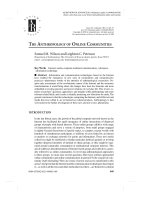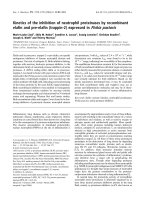The spindle of oocyte observed by polarized light microscope can predict embryo quality
Bạn đang xem bản rút gọn của tài liệu. Xem và tải ngay bản đầy đủ của tài liệu tại đây (349.17 KB, 6 trang )
Journal of military pharmaco-medicine no3-2018
THE SPINDLE OF OOCYTE OBSERVED BY POLARIZED LIGHT
MICROSCOPE CAN PREDICT EMBRYO QUALITY
Nguyen Thanh Tung*; Le Thanh Huyen*
SUMMARY
Objectives: To evaluate spindle position of mataphase (M) II oocyte and the development of
embryos origined from oocytes with spindle and without spindle. Subjects and methods: 250 MII
oocytes were analyzed with polarized microscopy in In vitro Fertilization Centre of Vietnam
Military Medical University. Results: Spindles were detected in 170 (77.98%) of 218 MII oocytes,
115 spindles (67.65%) of MII oocytes was beneath or adjacent to the first polar body, 55 oocytes
0
0
had the spindle located between 30 and 180 angle away from the first polar body. Fertilization
rate and good quality embryos in oocytes with a visible spindle (77.98% and 61.02%) were
higher than in oocytes without a visible spindle (22.02% and 36.84%), the difference was
significant with p < 0.001 and p < 0.05. Conclusions: Spindle position of MII oocytes did not
always beneath or adjacent to the first polar body. Fertilization rate and good quality embryos in
oocytes with a visible spindle were higher than in oocytes without a visible spindle.
* Keywords: Intracytoplasmic sperm injection; In vitro fertilization; Metaphase II oocyte;
Polscope; Spindle; Polarized light microscope.
INTRODUCTION
Ovarian stimulation to make multiple of
good oocytes and embryos is one of the
most important step to increase success
rate of in-vitro fertilization. The abnormal
genetic oocytes are made by ovarian
stimulation with impossibility in passing
the physical limitation can cause failure of
embryos development inside uterus.
Oocyte selection with best quality without
genetic abnormalities by non-invasive
technique is essential. Embryologists give
many morphological criteria to assess and
select good oocyte and put the embryos
into uterus.
Cytoplasm, zona pellucida, polar body
can be observed by conventional microscope
but some other parts of cell is invisible.
Polarized microscope allows embryologist
to observe morphology of the spindle. The
appearance of spindle helps us recognize
either oocyte maturation or the quality of
laboratory.
This research was conducted with aim:
Evaluation of spindle location of mature
oocyte and embryos development by
oocyte with spindle and oocyte without
visible spindle.
* Vietnam Military Medical University
Corresponding author: Nguyen Thanh Tung ()
Date received: 09/01/2018
Date accepted: 28/02/2018
116
Journal of military pharmaco-medicine n03-2018
SUBJECTS AND METHODS
1. Subjects.
Mature oocytes of IVF patients at IVF
Center of Vietnam Military Medical University
* Selection criteria:
+ Patients under 35 years old.
+ 3 ng/mL < AMH < 10 ng/mL.
+ The number of secondary follicle: 5 15 in second or third day of menses cycle.
* Exclusion criteria:
+ Polycystic ovary patient, low respond
to ovary stimulation.
+ Low quantity and quality sperm.
* Equipment and materials:
Incubator Cook (Australia) 37oC, mix
gas 6% CO2, 5% O2.
POLARIZED LIGHT MICROSCOPE Ti-U
Nikon TE2000 with Module polarAIDE Octax laser system, digital camera....
- Consumable: Culture box (Nunc), petri
dish 60 mm, needle using in ICSI technology.
- Spermrinse, oocyte washing, Embryo
Cultures of Vitrolife (Sweden).
Daily oocyte ultrasound until appeared
at least 3 follicles bigger than 17 mm.
Ovulation was trigger by hCG 5,000 IU
injection.
Oocyte retrieval after injection hCG
35 - 36 hours.
After retrieving, put oocytes in incubator
at 37oC, 5% CO2 for 2 hours.
Then denuding oocyte by enzyme
hyaluronidase.
Put fresh oocyte at 37oC for 1 hour.
Evaluate of maturation level of oocytes
and spindle before ICSI.
* ICSI technology (Intra - Cytoplasmic
Sperm Injection) (Palermo, 1992) [8]:
* Evaluation morphology of egg and
fertilization method (Kathy, 2000) [5]:
Mature oocyte (MII) showing round first
polar body without intact germinal vesicle.
Immature oocyte with visible germinal
vesicles (GV).
Immature oocyte (MI) without intact
germinal vesicle and polar body.
2. Methods.
Cross-sectional analysis study.
* Studied parameters:
Average age; FSH average dose; mature
oocyte rate; mature oocyte with spindle and
mature oocyte without observed spindle;
spindle position; fertilization rate of mature
oocyte with spindle and mature oocyte without
spindle; embryo quality in third day.
* Oocyte stimulation protocol:
Oocyte stimulation was used from the
second or third day of cycle, antagonist was
used from the sixth after using FSH day.
Pronuclear stage contains male nucleus,
female nucleus and 2 round polar body.
117
Journal of military pharmaco-medicine no3-2018
* Cultures:
After ICSI 16 - 18 hours, put zygote
into new medium (G1 plus).
Evaluate embryos in the second day,
and then put them into G2 plus in
incubator Cook.
Classify embryos in the third day based
on criteria of alpha of ESHRE 2011 [1].
* Data analysis:
Result were expressed by variables
average values and variables were showed
in figures and percentage (%).
Using student t-test or Chi-square (χ2)
to compare the variables.
The statistically valid test when p < 0.05.
RESULTS
Table 1: Age and FSH dose, the
average number of oocytes retrieved.
Index
29.65 ± 2.87
FSH dose (IU per day)
192 ± 29.69
60 - 120 120 - 180
degrees degrees
170
(100%)
10
(5.88%)
115
(67.65%)
40
(23.53%)
5
(2.94%)
The result of table 2 showed that in
which 170 visible spindle matured oocytes,
there were 115 oocytes (67.65%) with
spindle directly beneath and adjacent to
the first polar body, 40 spindle oocytes
(23.53%) located between 30 and 60
degrees angle away from the first polar
body, 10 spindle oocytes (5.88%) located
between 60 and 120 degrees angle, 5 spindle
oocytes (2.94%) located between 120 and
180 degrees angle.
10 ± 1.61
The average number of age: 29.65 ±
2.87, the youngest was 24, and the oldest
was 33. FSH dose per patient was 192 ±
29.69 IU/day. The average number of
oocytes retrieved was 10 ± 1.61.
* The classification of oocyte maturation:
The total of oocytes was 250 oocytes,
in which immature oocytes were 32
(10 oocytes in the prophase I (GV)
occurred 4%, 22 oocytes are in the MI
occurred 8.8%, 218 matured oocytes
occurred 87.2%.
* The rate of visible spindle in the
mature oocytes:
In 218 matured oocytes, there were
170 visible spindle oocytes (77.98%) and
48 spindle oocytes (22.02%) were not
observed.
118
Directly
MII with beneath and
30 - 60
visible adjacent to
degrees
the first
spindle
polar body
X ± SD
Age
Oocytes retrieved
Table 2: Spindle location.
Imagine 1: MII was observed by polarization
microscope, with magnification 200X (the
thin arrow: the first polar body. The bold
arrow: meiosis spindle, beneath the first
polar body, the left imagine showed that
the spindle located in 70 degrees angel
way from the first polar body).
Journal of military pharmaco-medicine n03-2018
Table 3: The fertilization rate of mature oocytes.
MII oocytes with visible spindle
The fertilization rate
MII oocytes
spindle
69.41% (118/170)
with
invisible
39.58% (19/48)
p
< 0.001
The fertilization rate of mature oocytes with visible spindle was 69.41%, whereas
that of mature oocytes with invisible spindle was 39.58%. The difference was
statistically significant with p < 0.001.
Table 4: The classification of third day embryos.
Classification
MII oocytes with visible
spindle
MII oocytes without visible
spindle
p
Good
61.02% (72/118)
36.84% (7/19)
< 0.05
Fair
27.12% (32/118)
47.37% (9/19)
> 0.05
Bad
11.86% (14/118)
15.79% (3/19)
> 0.05
Good embryos rate of MII oocytes with visible spindle was higher than of MII oocytes with
invisible spindle (61.02% and 36.84%). The difference was statistically significant with p < 0.05.
DISCUSSION
1. The presence of spindle on mature
oocytes.
In this research, oocytes were observed
at 39 hours after hCG administration, the
time that Cohen et al (2004) had observed
the spindle of MII oocytes with the highest
rate (81.5%) [2]. In 218 observed MII
oocytes, there were 170 visible spindle
oocytes (77.98%), similar to the result of
Cohen et al (2004), Heindryclx et al
(2011) [2, 4] (585/770 oocytes (76%);
891/1089 oocytes (81.9%), respectively).
In this research, in spite of 48 oocytes
with the first polar body, the rate of invisible
spindle oocytes was 22.02%. To explain
the absence of spindle in MII oocytes,
Montag et al (2006) used time-lapse to
observe the oocyte maturation in the
in-vitro and showed that when MI oocytes
extruded the first polar body, a spindle
had established the bridge between the
polar body and the oolemma for 75 - 90
minutes. These images was recorded at
telophase 1 by polarized microscope.
After extruding the first polar body, it took
115 - 150 minutes to establish the spindle
beneath the first polar body. Therefore,
the spindle was absent in the oocyte
meosis [7].
In ICSI, the spindle location of mature
oocyte is involved in the first polar body.
The ICSI micropipette has to avoid the
spindle in the injection. However, several
researches reported that the first polar
body did not exactly predict the spindle
location [9]. Thus, the spindle could be
injured when located far from the first
polar body. Using polarized microscope
119
Journal of military pharmaco-medicine no3-2018
could reduce spindle injured in ICSI. In this
research, there were 8 oocytes (8.7%)
with spindle located between 600 and
1,200 angle away the first polar body, this
location was for injecting by the ICSI
micropipette though out the 3-hour
position in the oocyte. To explain the
change of spindle location away from the
first polar body, in the oocyte denudation
by physical processing, the first polar
body was moved. Another reason was
that the fluid surrounding the spindle
forces its movement [6].
2. The fertilization and embryo quality.
Oocyte assessment by using polarizied
microscope improved the prediction of
oocyte quality. In the Woodward’s
research (2008), the fertilization rate and
embryo quality in day 3 and day 5 of the
oocyte MII with visible spindle was higher
and better than of the oocyte MII without
spindle [10]. In our research, fertilization
rates between two groups were significantly
statistically different (p < 0.05). This result
was similar to the result of Cohen et al
(2004), Heindryckx (2011) [2, 4].
Table 6: The fertilization rate of MII oocyte with or without visible spindle.
The fertilization rate (%)
Author
p
MII oocyte with visible spindle
MII oocyte without visible spindle
Our research
69.41% (118/170)
39.58% (19/48)
< 0.001
Heindryckx (2011)
78.2% (697/891)
65.2% (129/198)
0.0002
Cohen (2004)
70.4% (412/585)
62.2% (115/185)
0.035
There are many reasons for the IVF failure, in which the major reason is from
chromosome abnormalities and 80% of aneuploidy embryos are from the oocyte
meiosis 1 [3]. Chromosome dividing errors often happen in meiosis 1. The main
mechanism is the error in homologous chromosome pairing in prophase 1,
recombination and early dividing of chromosome. Spindle controlled the chromosome
movement though many periods in meiosis and has a crucial role in meiosis [2]. In this
research, the good embryos rate of MII oocytes with visible spindle was higher than of
MII oocytes with invisible spindle. Moon et al (2003) implemented in 626 MII oocytes,
the good embryo rate of MII oocytes with visible spindle 64.2% was higher than of MII
oocytes without spindle 35.9% (p < 0.01), and the rate of multi-pronuclear in MII
oocytes with visible spindle (3PN, 4PN) was reduced, compared with MII oocytes
without spindle (5.9% and 10.7%) [6].
CONCLUSION
REFERENCE
- The spindle location may be away far
from the first polar body.
1. Alpha Scientists in Reproductive
Medicine and ESHRE Special Interest Group
of Embryo. The istabul consensus workshop
on embryo assessment proceedings of an
expert meeting. Human Reproduction. 2011,
26 (6), pp.1270-1283.
- The fertilization and good embryo
rates of MII oocytes with visible spindle
are higher than that of MII oocytes without
observed spindle.
120
Journal of military pharmaco-medicine n03-2018
2. Cohen Y, Malcov M, Schwartz, Raz
Mey N, Carmon A, Cohen T, Amit A and
Azem F. Spindle imaging: a new marker for
optimal timing of ICSI?. Human Reproduction.
2004 , Vol 19, No 3, pp.649-654.
3. Hassold T, Hunt P. To err (meiotically; is
human the genesis of human aneuploidy. Not
Rev Genet. 2001, 2, pp.280-291.
4. Heindryckx B, Gheselle D.S, Lierman S,
Gerris J and Sutter D.P. Efficiency of
palarized microscopy as a predictive tool for
human oocyte quality. Human Reproduction.
0
2011, Vol 26, N 3, pp.535-544.
5. Kathy L, Sharpe T, Randall L, Zimmer.
Oocyte and pre-embryo classification. Hand
book of the assisted reproduction laboratory.
2000, pp.179-196.
6. Moon J.H, Hyun Ch.S, Lee S.W, Son
W.Y, Yoon S.H, Lim J.H. Visualization of the
metaphase II meiotic spindle in living human
oocytes using the polscope enables the prediction
of embryonic developmental competence
after ICSI. Human Reproduction. 2003, Vol 18,
0
N 4, pp.817-820.
7. Montag M, S.chimming T, Van der Ven
H. Spindle imaging in human oocyte the
impact of the meiotic cell cycle. Repro Biomed
Online. 2006, 12, pp.442-446.
8. Palermo G, Joris H, Devroey P,
Van Steirteghem A.C. Pregnancies after
intracytoplasmic injection of single spermatozoon
into an oocyte. Lancet. 1992, 340 (8810),
pp.17-18.
9. Silva C.S, Kapura K, Oldenboug R and
Keefe D.L. The first polar body doesn’t not
predict accurately the location of the
metaphase II meiotic spindle in mammalian
oocytes. Fertil. Reprod. 1999, 13, pp.719-721.
10. Woodward B, Montgomery S,
Hartshome G, Campbell K, Kennedy R.
Spindle position assessment prior to ICSI
does not benefit fertilization or early embryo
quality. Repro Biomed Online. 2008, 16,
pp.232-238.
121









